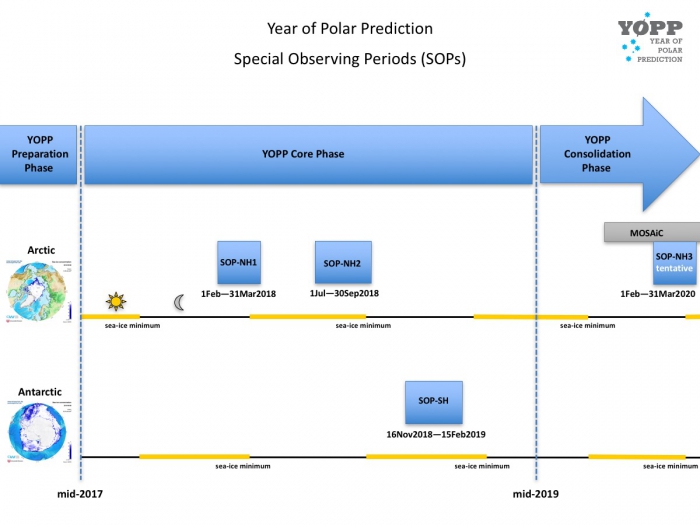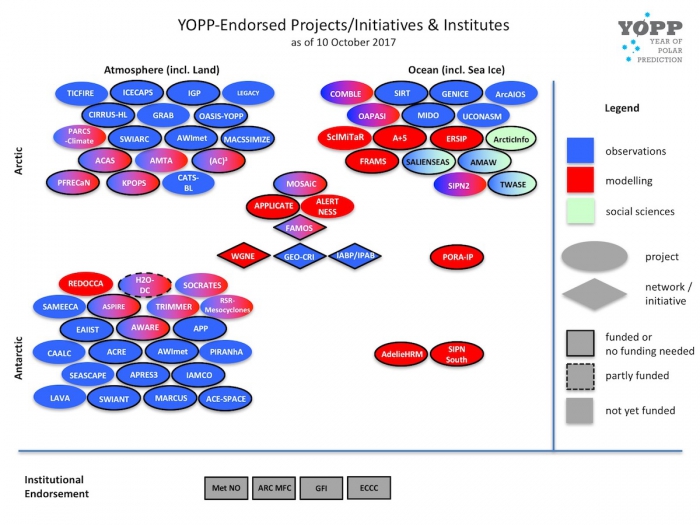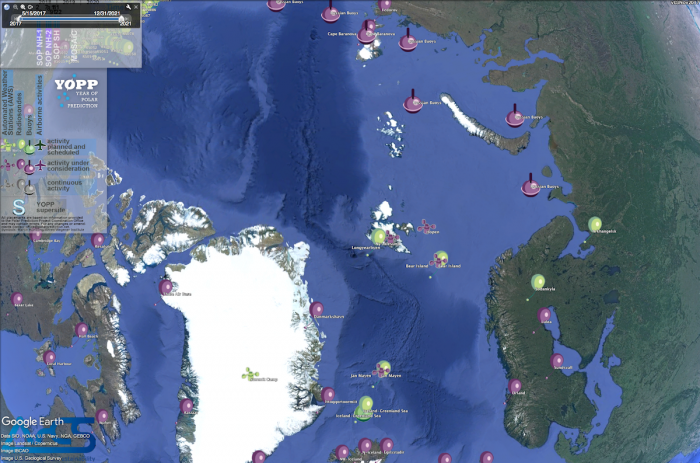By Kirstin Werner, Year of Polar Prediction International Coordination Office, Project Officer
Environmental and climate changes in the Arctic have significant impact on maritime traffic related to fisheries, scientific efforts, and tourism, and create potential risks to both humans and the natural environment. Precise weather and sea-ice predictions will play an increasingly important role in managing related safety issues in polar regions. The World Meteorological Organization (WMO) under the auspices of its World Weather Research Programme (WWRP) and the Polar Prediction Project (PPP) has initiated the Year of Polar Prediction (YOPP), a two-year international and interdisciplinary research initiative that will run from mid-2017 to mid-2019. The goal of the project is to significantly improve environmental prediction capabilities for the polar regions and beyond, on time scales from hours to seasons. YOPP was officially launched in May this year and entails intensive observing and modeling efforts in both the Arctic and the Antarctic.
Coordination
The German Alfred Wegener Institute, Helmholtz Centre for Polar and Marine Research hosts the International Coordination Office (ICO) for Polar Prediction, which serves as a focal point for the communication and coordination among the academic community and stakeholders involved with polar prediction topics. The ICO was established to support the PPP Steering Group in managing everyday activities and to coordinate, plan, and prepare details for the Year of Polar Prediction. Members of the PPP Steering Group represent both operational forecast centers and the science community within different WMO member states. YOPP Task Teams have been established in order to promote and coordinate specific activities during the Year of Polar Prediction.
Key Activities and Products
Two Special Observing Periods are planned for the Arctic region: 1 February–31 March and 1 July–30 September 2018. In the Antarctic, the Special Observing Period will take place 16 November 2018–15 February 2019 (See Figure 1). During these intensive observation phases, routine observations will be increased in an attempt to close gaps in the current observing systems. Extra observations, such as radiosonde launches and ocean buoy deployments, will allow for forecasting system experiments aimed at optimizing observing systems in the polar regions and providing insight into the impact of better polar observations on forecast skill. To ensure that all observations are considered in forecasting experiments, all data will be shared through WMO's Global Telecommunication System (GTS).

Endorsement
YOPP endorsement allows for improved coordination of activities relevant to its goals. Projects, programs, and initiatives that contribute to improving forecasting skills in polar regions can request endorsement by the YOPP initiative—about 65 activities have been endorsed to date (See Figure 2). Detailed information on timing and plans of YOPP-endorsed projects can be viewed via the YOPP Explorer. The endorsement process is also open for research institutes and operational forecasting centers whose activities contribute to the success of the YOPP initiative.

YOPP Observations Layer
Information about extra observations such as buoys, automatic weather stations, and radiosonde launches, as well as aircraft campaigns during the YOPP Special Observing Periods, can be browsed along different time slots (See Figure 3). Observations made during field campaigns of YOPP-endorsed projects are also included. As a living resource, the YOPP Observations Layer will be continuously updated in response to any new information received.

YOPP Data Portal
The majority of data generated and collected during YOPP observational campaigns, as well as by modelling and verification efforts, will be stored at separate national data centers and portals. The YOPP Data Portal provides metadata and links to these respective datasets. As a legacy for YOPP, this data portal takes into account the various requirements of end-users working with the YOPP data collection. The YOPP Data Portal is hosted by the Norwegian Meteorological Institute. The data publisher for Earth and Environmental Science PANGAEA, hosted by the German Alfred Wegener Institute, will be one of the data hubs. YOPP-relevant data will be flagged as a "YOPP" dataset in the label field of the PANGAEA database submission form.
How to Get Involved
Community members can receive updates on YOPP through various communication channels: mailing list, website, newsletter, and twitter. Additional ways to get involved with the Year of Polar Prediction include engaging in one of the YOPP Task Teams; requesting a YOPP endorsement; and as a researcher, making observation data available via the WMO Global Telecommunication System (WMO Information System WIS) and the YOPP Data Portal. Another great way of contributing to YOPP is to share deployment opportunities for instruments, such as buoys and floats. Any questions, comments, or ideas can be directed to the ICO at office [at] polarprediction.net.
For More Information
The first YOPP online conference, held on 17 October 2017, provided an update on the current status of preparations and planning of the initiative. Listen to the first YOPP online conference on &feature=youtu.be">YouTube.
Register for the next YOPP online conference, which is scheduled for Friday, 1 December 2017 at 4:00 p.m. (GMT). It is open to everyone interested in improving forecast skills in the polar regions. For more information, go to the Polar Prediction website.
 Prior to joining the International Coordination Office for Polar Prediction as project officer, Kirstin Werner studied the variability of heat transfer to the Arctic Ocean and corresponding changes in the sea-ice extent during the past ca 12,000 years at GEOMAR (Kiel, Germany), the Institute of Arctic and Alpine Research (Boulder, Colorado, USA), and the Byrd Polar and Climate Research Center (Columbus, Ohio, USA). Her new focus at the Alfred Wegener Institute in Bremerhaven, Germany, is on the science management aspects of short-term polar weather and climate variability during the Year of Polar Prediction. Kirstin recently completed an on-the-job MSc program in Science Marketing at the Technical University Berlin, Germany.
Prior to joining the International Coordination Office for Polar Prediction as project officer, Kirstin Werner studied the variability of heat transfer to the Arctic Ocean and corresponding changes in the sea-ice extent during the past ca 12,000 years at GEOMAR (Kiel, Germany), the Institute of Arctic and Alpine Research (Boulder, Colorado, USA), and the Byrd Polar and Climate Research Center (Columbus, Ohio, USA). Her new focus at the Alfred Wegener Institute in Bremerhaven, Germany, is on the science management aspects of short-term polar weather and climate variability during the Year of Polar Prediction. Kirstin recently completed an on-the-job MSc program in Science Marketing at the Technical University Berlin, Germany.
Photo courtesy of Martina Buchholz, Alfred-Wegener-Institut.
